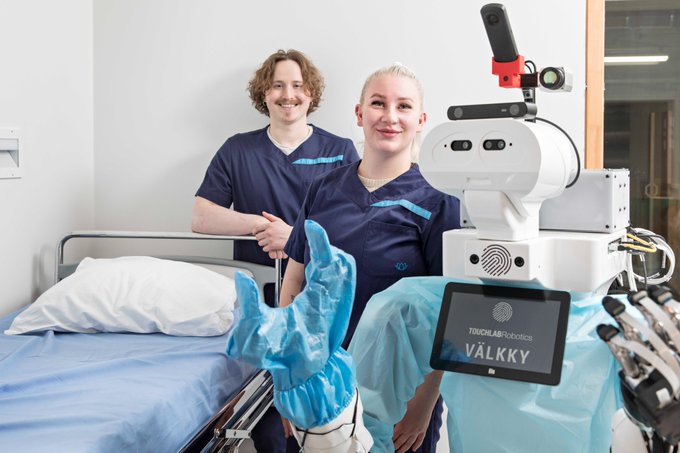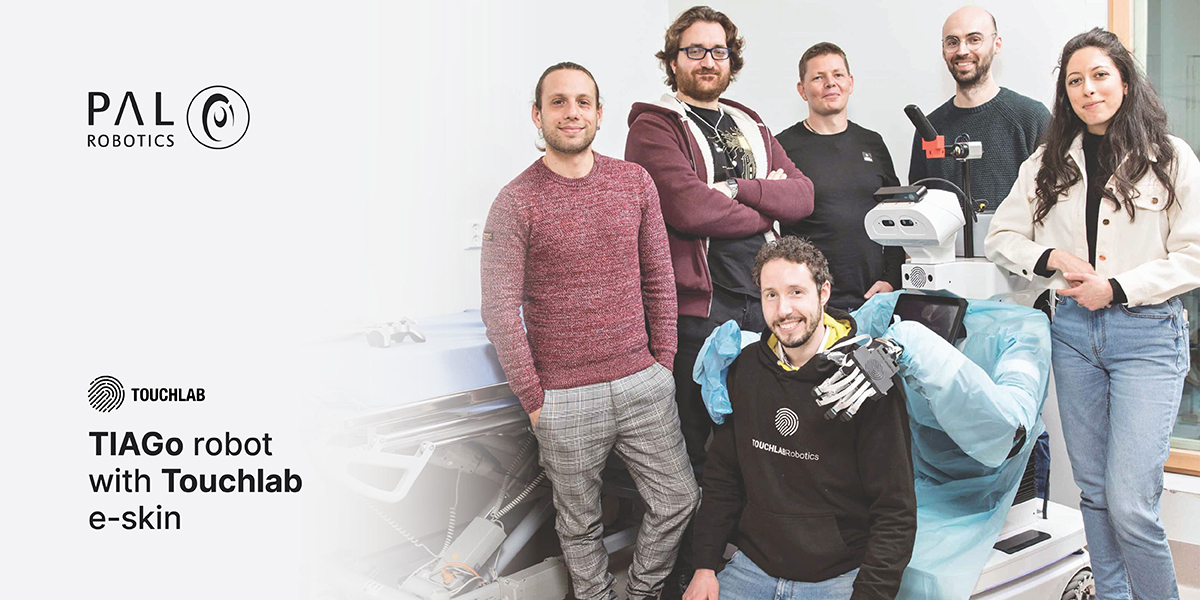We recently had the opportunity to talk with Dr. Zaki Hussein, the CEO & Founder of Touchlab, the award-winning startup that exists to solve the great challenge of touch in robotics, and specialises in electronic skin (e-skin) and teleoperated avatar technology. During our interview, we asked more about the mission and founding of the company, and delved into the company’s project at Laakso Hospital, where the robot Välkky, an adapted version of TIAGo robot by PAL Robotics is using its newly developed sense of touch to help healthcare staff and patients.
Inspiration to work in robotics, founding startup Touchlab, and reaching the finals of the ANA Avatar XPRIZE
Zaki told us more about how we first became interested in robotics, “since I was 14 years old and living in Finland, I dreamt of working in nanotechnology and robotics. I was fascinated by the idea of tiny robots that could go inside our body and cure diseases. During my undergraduate studies, I got a taste of the start-up scene, then becoming a full-time lead software developer for a VR stroke rehabilitation spinout. Upon completing my degree, I moved to Scotland to acquire a PhD in ‘Intelligent Sensing and Measurement’ at the University of Edinburgh and Glasgow, specialising in micro- and nanofabrication. With deep technical and sector-specific experience, I founded Touchlab as CEO.”
Telling us more about the beginnings of Touchlab, Zaki explained, “Touchlab began during the final years of my PhD. After working in the sensors domain for some time and evaluating countless types of sensors, it became clear that there was a major challenge within the robotics space – they were missing the sense of touch. Our company was founded to solve this problem, and so we set out on a path to develop the world’s most advanced, compliant, electronic skin (e-skin). By the end of 2022, Touchlab had reached the finals of the ANA Avatar XPRIZE as one of only 16 teams globally.” XPrize is a non-profit organisation that designs and hosts global public competitions intended to encourage technological development to benefit humanity.
Touchlab is based in The National Robotarium, in Edinburgh – a multimillion-pound, purpose-built facility with advanced technology and laboratories for the development and testing of robotics and AI solutions.
Developing avatars to help solve challenges in healthcare and support hospitals
Zaki shed light on the pressing issue faced by Finland, being home to one of the world’s oldest populations after Japan. “This is already a very tangible problem in Finnish society, with overloaded hospitals and not enough staff to care for patients,” he explained. To help tackle this, Touchlab’s work aims to develop innovative platforms that can help solve challenges such as this one. “AI alone cannot address all hospital problems, and robots are not yet fully automated to function effectively in unstructured environments,” Zaki emphasised. “Therefore, Touchlab’s proposal involves deploying avatars that can alleviate nurse fatigue, prevent repetitive strain injuries, and reduce both commuting time and personal protective equipment (PPE) preparation time.”
TIAGo becomes Välkky robot: a breakthrough in Human-Robot Interaction with e-skin technology
To help address this challenge, the team has been carrying out a 5-month pilot project at Laakso Hospital in Helsinki, where purpose-trained nurses are collaborating to explore how robotics systems can revolutionise healthcare delivery, alleviate workload, and curb the spread of infections.
As part of this project, Touchlab has developed the Välkky system, a platform built on the TIAGo robot, designed by PAL Robotics. In this project, the robot operates over a wireless network, even over long distances. It replicates the real-time movements of the nurse’s body, hands, and head, and through the use of electronic skin, provides a sense of touch to the nurse controlling the robot. Zaki explained, “Touchlab’s e-skin is thinner than human skin making it easily retrofittable without reducing the robot’s or gripper’s degrees-of-freedom (DoF). Machines fitted with Touchlab’s e-skin can now roll pens, grasp soft objects, and even detect slip (and compensate for it). The uniqueness of the technology lies in its low-profile and ability to conform to almost any surface (including curved), without negatively impairing sensor performance such as the force-range or accuracy. The sensor is extremely durable, and can withstand extreme environments such as high or low pH and even radioactive environments.”
Furthermore, as Zaki explained, this technology can transmit real-time sensations. “Our e-skin technology is composed of thin tactile sensors that can be wrapped around hard or soft robots. These ultra-thin force sensors transmit real-time sensations such as pressure, vibration, or motion to the user,”.
Zaki added, “when using the telerobot, a proxy is installed between the healthcare provider and patient, which is expected to reduce the transmission of healthcare-acquired infections (HAI’s). Furthermore, additional robotic functionality is expected to enhance delivery of care with for example thermal vision to assess patient temperature.”
Touchlab’s expertise extends to fabric-based sensors deployed on the robot’s body to detect accidental contacts and social cues, and the team are trialling different ways to communicate this tactile data to the operator. The integration of custom grippers, including a Robotiq 2-finger gripper and an anthropomorphic Schunk SVH gripper, with upgraded control software and integrated force sensing in each fingertip, adds to the robot’s versatility.
Operators can use a wearable haptic glove to control the Välkky system. The robot can serve meals, move assistive devices, or help brush a patient’s hair. The hope is that Välkky will free staff to focus on more complex nursing tasks while the robot carries out routine clinical duties, such as measuring pulse, temperature, and blood oxygen levels. During the trial at Laakso Hospital the team of trained nurses will explore how robots can help deliver care, reduce workloads, and prevent the spread of infection.
This project, undertaken in collaboration with Forum Virium Helsinki, Helsingin kaupunki – Helsingfors stad – City of Helsinki, Laakso Hospital, and Suomen Digitaalinen Tehdas as part of the FinEst Twins EU piloting program, has been in development for 2-3 years. It represents an unprecedented endeavour in human-robot interaction (HRI), with Välkky setting new standards in healthcare provision.

Adapting TIAGo robot for the Laakso Hospital project with e-skin
The modular software architecture of TIAGo played a crucial role in the Laakso Hospital project’s success, enabling the extension and enhancement of the robot’s capabilities. Zaki affirmed, “TIAGo has been integral to The Touchlab Avatar system. The modular software architecture allowed us to extend and enhance the robot capabilities. All of the work on control was only possible because of the modularity of the core system.”
Zaki added, “we have been using the provided tools for starting our software and hardware components using the WebCommander. This greatly improved the efficiency of our testing and debugging. We have been using the Text-To-Speech features extensively, including the multiple languages provided. This has really helped communicate the status of the robot.”
Zaki continued, “The additional connection on the AUX panel also allowed us to build our own extensions to the vision system and add compute power to the robot.” The TIAGo’s WIFI antennas proved to be another essential feature, providing stable connectivity and high bandwidth across the different WIFI networks at the hospital, in addition Zaki commented, “The battery has also been a very strong point. We can operate a full day without needing to recharge.”
The team also redesigned the robot’s control architecture, incorporating a fine zone-controlled velocity limiting to the mobile base and implementing a real-time whole-body controller with self-collision avoidance and strict limits on safety and smoothness. Zaki added, “We are currently experimenting with impedance control to introduce an additional layer of compliance and safety.”
E-skins, tele-operated avatar technology over distances and future projects
Zaki described some of the cutting-edge technologies and techniques that Touchlab uses in its robotics projects, “Touchlab’s flagship technology is the triaxial sensor – a low-profile multi-directional tactile sensor that can be wrapped around robots as ‘electronic skin’ (e-skin).”
Zaki continued, “The e-skin also performs as a platform for Tele-operated avatar technology, where an operator can hear, see, speak, and touch through an avatar. This technology is enabled by the (traditionally missing) sense of touch and has been demonstrated over a distance of ~9000 kilometres (Helsinki to Los Angeles). It could easily become part of the future of work, enabling telecommuting, especially in dangerous environments. Towards this we are now trailing our real-time telerobotics platform. This consists of an operator interface in VR, a low-latency video, audio and data streaming software, haptic rendering tools that use both visual tools and tactile rendering directly on the operator skin.”
Regarding future directions that Touchlab is exploring in the field of robotics, Zaki told us, “Our current focus is on supporting labour shortages in the healthcare sector which is a monumental challenge, affecting healthcare systems around the world. Given the scale of this, our future work sees Touchlab improve the teleoperated robot avatar, ahead of future deployments.”
Zaki continued, “Teleoperation is a first step for us towards building a true shared autonomy. As we collect data and work with customers on their high-value applications, we are preparing to build an autonomy stack. This will then integrate with our teleoperation platform to give the operator high-level control of the robot. It will allow them to automate repetitive tasks while keeping the operator in control and allowing them to jump into full teleoperation when the autonomy needs a helping hand.”
Zaki concluded, “We always enjoy collaborating with companies that share our ambitions. We were delighted to partner with PAL Robotics for the Laakso Hospital project, for example, and we have also been collaborating with HaptX to develop the to-date most advanced haptic grasping interface by combining our sensors with the HaptX gloves.”
TIAGo robot, the customisable solution for perception, navigation, manipulation & Human-Robot Interaction
TIAGo robot combines perception, navigation, manipulation & Human-Robot Interaction skills out of the box and the modular robot with various customisations is a popular choice for researchers. Recently, advanced mobile manipulator TIAGo Pro also joined the TIAGo family of robots. TIAGo Pro’s innovations revolve around fully torque-controlled arms and placement that enhances the robot’s manipulation capabilities, along with state-of-the-art Human-Robot-Interaction abilities.
We would like to thank Dr. Zaki Hussein for taking the time to talk with us. To learn about the capabilities of our research robot TIAGo take a look at PAL Robotics’ website. Finally, if you would like to ask us more about TIAGo as a research platform, do not hesitate to get in touch with us. To stay tp-to-date with all the latest news, remember to visit our blog homepage. To learn more about Touchlab’s work and future projects, you can visit their website.
